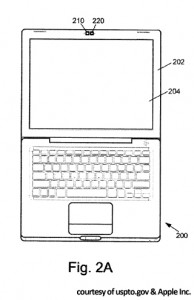Apple Inc.’s (NASDAQ:AAPL) researchers churn out far more outstanding technical ideas than ever see the light of day in a real product, but one notion – splitting iPhone cameras into two separate components, each with its own lens – may stand a better chance than most of emerging from the mists of “vaporware.” This intriguing notion came to light yesterday in a patent application granted and published by the U.S. Patent and Trademark Office (USPTO) among a bundle of 43 others won by the Cupertino electronics firm.
The camera is one of the major obstacles to creating an iPhone significantly thinner than current models. Though the thinness of electronics has become a major selling point, and seemingly a significant portion of the items’ aesthetics from the point of view of many consumers, the module needed for taking photographs has put a limit on how much thickness can be pared down. This, however, may change in the near future.
 The patent describes a setup where two separate sensors would capture different data from the same image, which would then be electronically combined to create a complete picture in the innards of the iPhone’s processor. This would, in effect, be the creation of a camera with two lenses that captured images simultaneously and superimposed them over one another. Apple’s (AAPL) design would solve the problem of thickness, since each of the twinned camera sensors could be much thinner than a single camera that handled the full spectrum of data from each image. Such an advance would permit the iPhone to slim down even further.
The patent describes a setup where two separate sensors would capture different data from the same image, which would then be electronically combined to create a complete picture in the innards of the iPhone’s processor. This would, in effect, be the creation of a camera with two lenses that captured images simultaneously and superimposed them over one another. Apple’s (AAPL) design would solve the problem of thickness, since each of the twinned camera sensors could be much thinner than a single camera that handled the full spectrum of data from each image. Such an advance would permit the iPhone to slim down even further.
In this arrangement, one lens would photograph only “luma,” or the part of the image related only to light and dark. This photo would be essentially black and white. The other lens would photograph “chroma,” or color. The pixels of each identical image would then be correlated geometrically by the onboard electronics, which would produce a crisp, accurate color photo of extraordinarily high quality.
The patent itself, United States Patent 8,681,250, names Michael F. Culbert and Chris Ligtenberg as the inventors of record, with Apple Inc. naturally being the assignee. The patent application was file on December 20th, 2011. Mr. Culbert was an active inventor, who has filed 47 patent applications with the USPTO, 23 of which have been granted. He worked as a Technology Director at Apple, but died of cancer in April 2013 after a 25 year career. His colleague, Mr. Ligtenberg, works in Product Design Architecture at the Cupertino firm. He has contributed to an impressive 156 patent applications, of which 72 have been granted to date.
This patent could represent a significant step forward in the quest to design ever thinner smartphones. The fact that the dual camera sensors produce a superior image to single-sensor cameras of similar capacity is also an interesting technological development. If Apple chooses to implement this feature on a future iPhone – perhaps the iPhone 7 – it may open the door to further advances leading to even leaner smartphone profiles.



